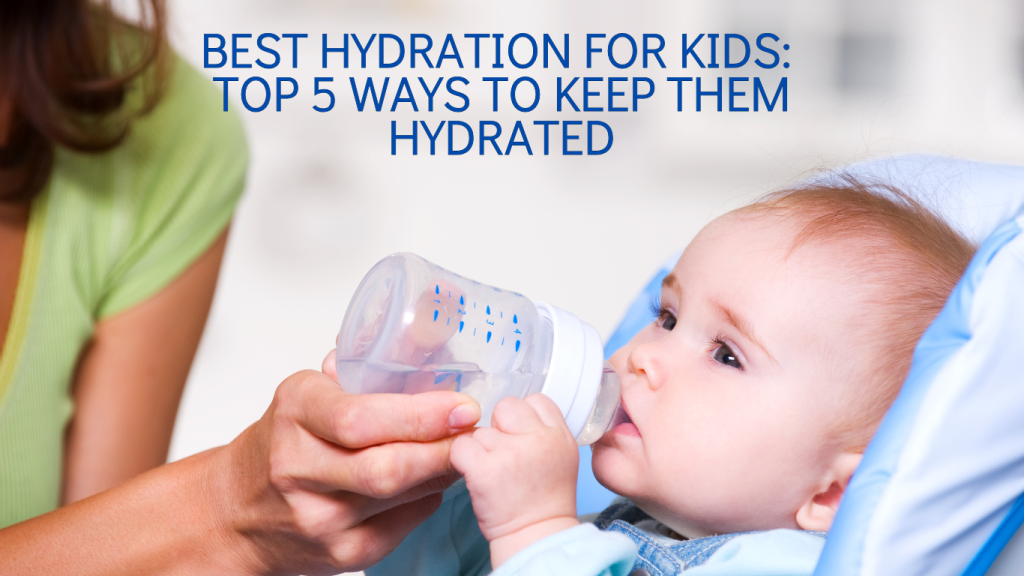We all know that the human body is more than half water. While this looks like a lot, children can get dehydrated very easily because they lose a lot of water through sweat compared to the average adult.
Dehydration can cause major medical issues and impact your child’s performance in physical activities and daily life.
Dehydration may occur at any time of the year, particularly in the summer. Children and newborns are more sensitive to dehydration than adults. If your child feels thirsty, they are likely already dehydrated. As parents, we have to ensure the best hydration for kids.
What Are the Signs of Dehydration in Children?
60% to 70% of a child’s body is made of water. When they lose too much of that water—through sweat or a viral infection that causes a high body temperature, nausea, and diarrhea—they become dehydrated.
Healthy hydration for kids is important as they may not have any symptoms if they are only slightly dehydrated. However, you could see the following symptoms if they remain dehydrated for a longer time:
- Darker than normal pee
- Less pee
- Crying with no tears
- Increased tiredness
- Dry mouth
- Sleeping longer than normal
- Feeling dizzy or lightheaded
Unfortunately, children may be unable to communicate when they are thirsty or feeling sick. This indicates that dehydration might occur without warning signals. To make matters worse, children are more likely to get dehydrated than adults since they sweat more water through their skin.
How Much Water Should a Child Drink in a Day?
The table below gives broad suggestions for the required daily intake of water for children of different ages.
| Age | Drink Volume (oz/ml a day) |
| 1 – 4 Years | 28 oz / 820ml |
| 4 – 7 Years | 32 oz / 940ml |
| 7 – 10 Years | 33 oz / 970ml |
| 10 – 13 Years | 40 oz / 1170ml |
| 13 – 15 Years | 45 oz / 1330ml |
| 15 – 19 Years | 52 oz / 1530ml |
Hydration Tips for Children
Children are comparatively prone to dehydration. A busy kid doesn’t think about drinking water initially. Children might not realise they are thirsty until they are dehydrated. Water should be available whenever you are with your kid and offered every couple of hours, or more frequently in the hot summer, dry winter, or even humid monsoon.
Here are some hydration tips for children that you can follow to keep your child healthy.
Start Early
Develop the habit of drinking water from a young age. Encourage them to drink glasses of water at regular intervals. Encourage your kid to drink water at certain intervals throughout the day, such as before meals, after playing, and during snacks. This helps to establish a consistent hydration routine.
Go Creative with Their Water Bottles
You can buy fun, eye-catching bottles, hydro flasks, or straw cups. A colourful water bottle featuring a playful design or your child’s favourite character can encourage them to drink more. You can also make it a fun activity by involving your kids in decorating plain bottles with DIY art. This will also help babies develop their fine motor skills and engage in sensory play.
Make Drinking Water Fun
Plain water can sometimes be boring for kids. If your child finds water plain or boring, add some slices of fruits like lemon, lime, or strawberries. Herbs such as mint or basil can add an exciting flavour to water.
One of the best ways to keep kids hydrated is to make it fun and exciting for them. Smoothies, milkshakes, homemade popsicles, and coolers are perfect options for combining hydration with a nutritious snack that kids will love.
The Happy Eaters app is filled with fun and creative recipes that not only taste great but also help keep your child hydrated.
Smoothie Ideas:
- Walnut Apple Smoothies: Apples are a great source of water, helping to replenish fluids in the body. Walnuts provide healthy fats, which can aid in nutrient absorption and help your kid maintain a hydration balance.
- Blueberry Chia Seed Smoothie: Blueberries are high in water content, providing essential hydration. Chia seeds are a fibre-rich food that can help regulate fluid balance and promote digestive health.
- Mango Almond Smoothie: Mangoes are a juicy fruit that can help your little one quench thirst and replenish fluids. Almonds provide healthy fats, which can aid in nutrient absorption and help maintain hydration balance.
Milkshake Ideas:
- Musk Melon Milkshake: Musk melons are packed with essential vitamins and minerals, supporting overall health and hydration. Their high water content makes them a natural choice for hydration.
- Banana Milkshake: Bananas are a good source of potassium, an electrolyte that helps your baby regulate fluid balance in the body.
- Pear Milkshake: Pears are a good source of water, helping to replenish fluids in the body.
Homemade Popsicle Ideas:
- Fruity Popsicles: Fruity popsicles made with fresh fruits and water are a great way for your baby to stay hydrated while enjoying a sweet treat.
- Breastmilk Popsicles: Breastmilk popsicles are a nutritious way to provide your baby with essential nutrients and hydration.
Cooler Ideas:
- Fruity Water: A delightful and refreshing way to keep babies hydrated while providing essential vitamins and minerals.
- Rose Delight: A soothing drink that can help promote relaxation and hydration in babies.
- Lychee Mint Ginger Cooler: A tangy and refreshing drink that can stimulate babies’ senses and promote hydration.
Be the Role Model
Kids love to emulate. If your child observes you drinking water throughout the day, they’ll probably want to follow suit. Make hydration a family activity! Drink water together before or after mealtime or after some outside playtime. It promotes good connections with hydration.
Water-Rich Foods
One of the best ways to keep kids hydrated is to add hydrating foods to their diet. This is a tasty and healthy strategy for increasing hydration. Many fruits and vegetables are high in water content, making them ideal for keeping your child hydrated. The Happy Eaters App offers a huge variety of amazing recipes that can help you provide a balanced and well-hydrated diet for your child.
Watermelon
Watermelon contains more than 90% water, making it one of the most hydrating meals.
- 6-10 months: Cut and remove the seeds of the watermelon into long, thin “watermelon sticks” for your baby to grab and gum safely.
- 10-18 months: Chop and remove the seeds of the watermelon into bite-sized pieces perfect for little fingers to pick up and munch on.
- 18 months and beyond: Let your baby enjoy this refreshing watermelon cut in any shape or size. Don’t forget to remove the seeds.
Pear
Pears are another hydrating fruit that may be prepared in a variety of ways based on your baby’s age.
- 6-10 Months Old: Peel the pear and cut it into paper-thin, round slices. These melt easily to prevent choking.
- 10-18 Months Old: Cut the pear in half (lengthwise, core removed). Offer one half at a time, allowing them to practise holding and gumming the soft flesh.
- 18 Months and Older: Offer pear slices. Cut them into thin wedges. Make sure they’re not too thick to avoid choking hazards.
You can adjust the size and shape of the pieces based on your baby’s individual development.
Mango
For babies who enjoy sweets, mango is the ideal fruit because it is not only hydrating but also creamy and flavorful. It is a win-win for nutrition and hydration because it is full of vitamins and water.
- 6-10 Months Old: Peel the ripe mango, deseed it, and cut it lengthwise into small, soft slices.
- 10-18 Months Old: Cut the ripe mango into small, cube-shaped pieces that are easy for your baby to grasp and gum.
- 18 Months and Older: Offer regular-sized mango cubes.
Stay ahead of the thirst game and keep your kids hydrated. Offer water and other hydrating foods and drinks all day long. Every time you leave the house with your kids, keep travel bottles handy and make sure they are full. Happy hydration!





